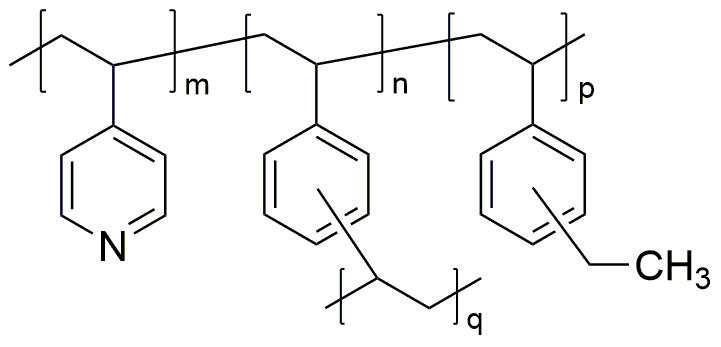Poly(4-vinylpyridine-co-ethylvinylbenzene), cross-linked, 25 % cross-linked with divinylbenzene is widely utilized in research focused on:
- Ion Exchange Resins: This chemical is used to create ion exchange resins, which are essential in water purification processes. They effectively remove unwanted ions from water, making it safe for drinking and industrial use.
- Adsorbents in Chromatography: Its unique structure allows it to function as an effective adsorbent in chromatography, aiding researchers in separating and analyzing complex mixtures in pharmaceuticals and environmental studies.
- Drug Delivery Systems: The material is utilized in developing drug delivery systems due to its biocompatibility and ability to control the release of therapeutic agents, enhancing the effectiveness of treatments.
- Sensor Technology: It plays a role in sensor technology by being incorporated into sensors that detect specific chemicals or biological markers, which is crucial in medical diagnostics and environmental monitoring.
- Polymer Composites: The compound is used in formulating polymer composites that exhibit improved mechanical properties, making them suitable for applications in automotive and aerospace industries.
General Information
Properties
Safety and Regulations
Applications
Poly(4-vinylpyridine-co-ethylvinylbenzene), cross-linked, 25 % cross-linked with divinylbenzene is widely utilized in research focused on:
- Ion Exchange Resins: This chemical is used to create ion exchange resins, which are essential in water purification processes. They effectively remove unwanted ions from water, making it safe for drinking and industrial use.
- Adsorbents in Chromatography: Its unique structure allows it to function as an effective adsorbent in chromatography, aiding researchers in separating and analyzing complex mixtures in pharmaceuticals and environmental studies.
- Drug Delivery Systems: The material is utilized in developing drug delivery systems due to its biocompatibility and ability to control the release of therapeutic agents, enhancing the effectiveness of treatments.
- Sensor Technology: It plays a role in sensor technology by being incorporated into sensors that detect specific chemicals or biological markers, which is crucial in medical diagnostics and environmental monitoring.
- Polymer Composites: The compound is used in formulating polymer composites that exhibit improved mechanical properties, making them suitable for applications in automotive and aerospace industries.
Documents
Safety Data Sheets (SDS)
The SDS provides comprehensive safety information on handling, storage, and disposal of the product.
Product Specification (PS)
The PS provides a comprehensive breakdown of the product’s properties, including chemical composition, physical state, purity, and storage requirements. It also details acceptable quality ranges and the product's intended applications.
Certificates of Analysis (COA)
Search for Certificates of Analysis (COA) by entering the products Lot Number. Lot and Batch Numbers can be found on a product’s label following the words ‘Lot’ or ‘Batch’.
Numéro de catalogue
Numéro de lot/série
Certificates Of Origin (COO)
This COO confirms the country where the product was manufactured, and also details the materials and components used in it and whether it is derived from natural, synthetic, or other specific sources. This certificate may be required for customs, trade, and regulatory compliance.
Numéro de catalogue
Numéro de lot/série
Safety Data Sheets (SDS)
The SDS provides comprehensive safety information on handling, storage, and disposal of the product.
DownloadProduct Specification (PS)
The PS provides a comprehensive breakdown of the product’s properties, including chemical composition, physical state, purity, and storage requirements. It also details acceptable quality ranges and the product's intended applications.
DownloadCertificates of Analysis (COA)
Search for Certificates of Analysis (COA) by entering the products Lot Number. Lot and Batch Numbers can be found on a product’s label following the words ‘Lot’ or ‘Batch’.
Numéro de catalogue
Numéro de lot/série
Certificates Of Origin (COO)
This COO confirms the country where the product was manufactured, and also details the materials and components used in it and whether it is derived from natural, synthetic, or other specific sources. This certificate may be required for customs, trade, and regulatory compliance.


